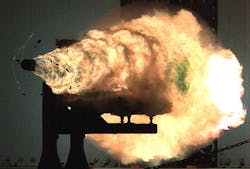Saft to provide energy storage and power electronics support for Navy electromagnetic railgun
Officials of the Naval Surface Warfare Center (NSWC) in Dahlgren, Va., announced plans Wednesday to award a sole-source contract to Saft to help Navy researchers develop non-propagating energy storage modules for the future electromagnetic railgun.
The Navy's electromagnetic railgun project seeks to use magnetic fields created by high electrical currents to accelerate a sliding metal conductor between two rails to launch projectiles at 4,500 miles per hour -- or nearly six times the speed of sound.
Such a shipboard weapon would use kinetic energy, rather than explosives, to destroy or disable targets at sea, such as surface warships, fast attack boats, helicopters, and fixed-wing aircraft.
Related: Navy chooses L-3 to develop energy storage technologies for electromagnetic railgun
Saft designs integrated battery solutions to power a wide range of military equipment such as infantry communications, weapons, torpedoes, unmanned underwater vehicles, aircraft, and hybrid armored vehicles. The value of this contract has yet to be negotiated.
The Navy's future electromagnetic railgun will use electricity generated by its host ship and stored over several seconds in a pulsed power system.
story continues below
The weapon sends an electric pulse to the railgun to create an electromagnetic force accelerating a projectile that looks like a gigantic blunt-end open wrench to speeds as fast as Mach 6. The wrench-like projectile moves so quickly that it trails a plume of fire from its kinetic energy.
The weapon would eliminate the hazards of high explosives in the ship and unexploded ordnance on the battlefield, Navy officials say. NSWC-Dahlgren performs research in complex naval warfare systems, such as the electromagnetic railgun and the shipboard Laser Weapon System (LaWS). Historically Dahlgren was in charge of developing naval guns.
When fully developed, the railgun will provide increased velocity and extended range over traditional shipboard weapons. The new weapon will be able to conduct precise, long-range naval surface fire support for land strikes; ship self-defense against cruise and ballistic missiles; and surface warfare to deter enemy vessels.
Related: Navy moves closer to deploying electromagnetic railgun shipboard weapon at sea
The Navy’s near-term goal is a 20- to 32-megajoule weapon that shoots a distance of 50 to 100 nautical miles. Navy officials want a rate of fire for the electromagnetic railgun of at least 10 rounds per minute. The pulsed power system will provide the electrical power necessary for this rate of fire.
Navy researchers also are working with L-3 Communications Applied Technologies Inc. in San Leandro, Calif.; and K2 Energy Solutions Inc. in Henderson, Nev., to develop power-storage technologies for the electromagnetic railgun project.
In 2012 Navy experts tested a 32-megajoule prototype demonstrator, built by BAE Systems at the Naval Surface Warfare Center-Dahlgren General Atomics built a second launcher. General Atomics, BAE Systems, are working on a pulsed power system for the electromagnetic railgun.
On this upcoming contract Saft engineers will provide 3,750 hours of engineering and technical support for battery systems development, modeling, and test for the electromagnetic railgun project.
Saft has provided direct support for the energy storage module development since 2014, and is the only responsible party able to support this project, Navy officials say.
For more information contact Saft America online at www.saftbatteries.com, or the Naval Surface Warfare Center-Dahlgren at www.navsea.navy.mil/Home/WarfareCenters/NSWCDahlgren.
